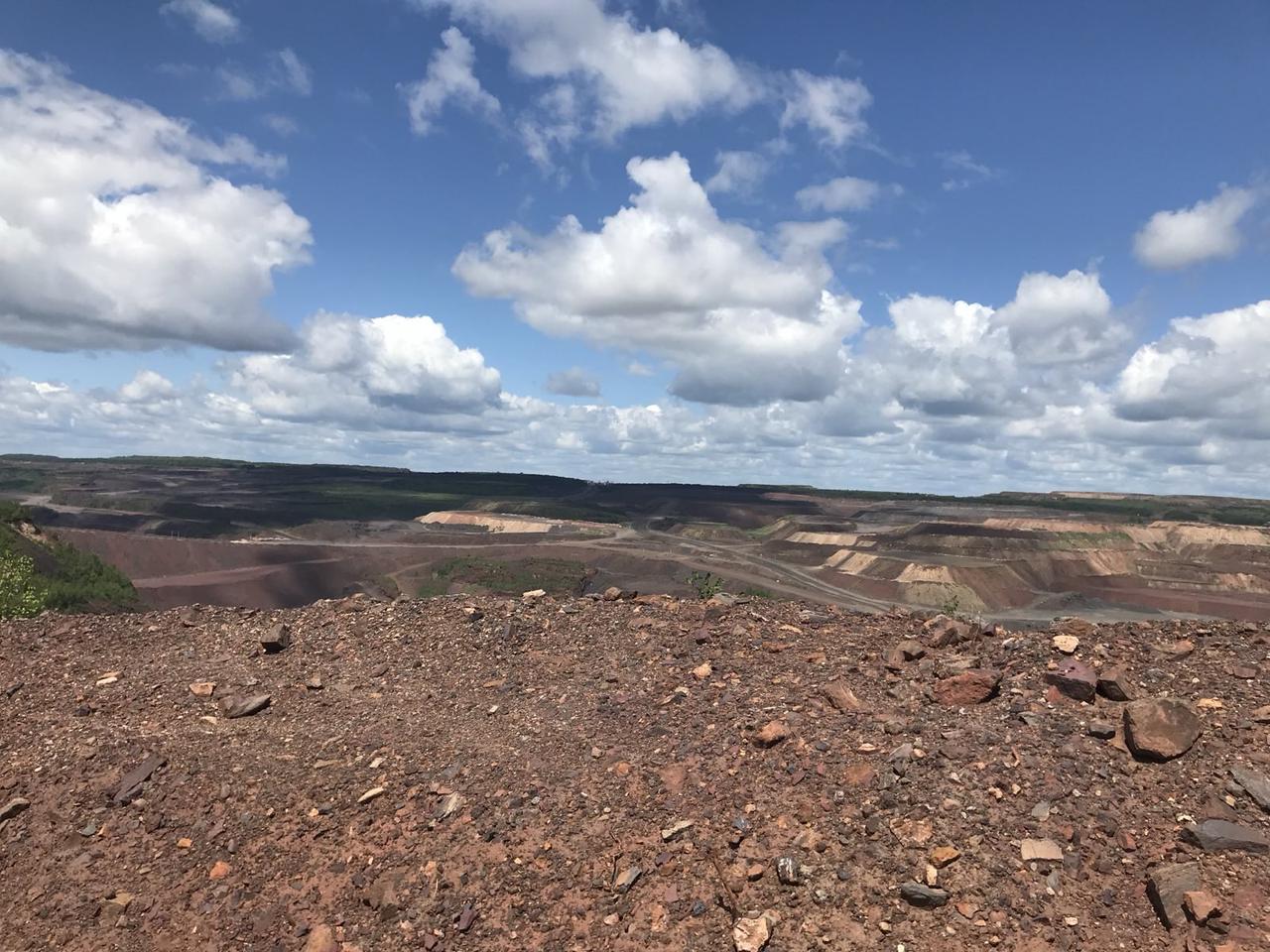 I am continuing with my detour from programming languages, single board computers, math, and financial markets to pen another piece on the Mesabi Iron Range; it is an expansion on a conversation I had with Pular Helium's geologist about iron mining's 140 year legacy on the land and its people.
I am continuing with my detour from programming languages, single board computers, math, and financial markets to pen another piece on the Mesabi Iron Range; it is an expansion on a conversation I had with Pular Helium's geologist about iron mining's 140 year legacy on the land and its people.
A number of years ago, I brought a friend of mine with me to The Range. He grew up in Sydney, Australia but has come to call Minneapolis home. He had never been to The Range and I wanted to show him some of the landscape of the area. We drove to the Hull-Rust-Mahoning Mine Overlook. He stood silently, staring out into Minnesota's largest open pit mine. He broke his silence with, "It looks like Mordor." I told this story to Pulsar Helium's geologist while we waited for the rest of the party to arrive for our drive to their Jetstream #1 bore site. He laughed and said, "Keeping with Lord of the Rings, to me, a mine is like The Shire."
I grew up in Hibbing, in the 1980s and 1990s, finally leaving for college a little after the turn of the millennium. My mother took care of the house and my sister and I; our father worked at U.S. Steel's Minntac mine 22 miles away as a cost analyst and finance manager. His efforts at the mine put food on our table, a nice roof over our heads, and a car or truck for each of us as my sister and I as we went off to college.
I am by no means "anti-mining," I have had stock and options in ArcelorMittal, U.S. Steel and Cleveland Cliffs over the years (currently I am long shares of Cleveland Cliffs). I simply feel that amongst the politicians' cries for "jobs, jobs, and jobs," the Faustian Bargain that the people of the Range figuratively struck with Mephistopheles gets lost and is rarely talked about.
A Brief History of the Mesabi Iron Range
The Mesabi Iron Range, located in northeastern Minnesota, is one of the largest iron ore deposits in the world. For almost a century and a half, the range has been a hub for iron mining, with production peaking in the mid-20th century. The discovery of iron ore in the late 1800s led to a mining boom that transformed the region into a thriving industrial center. At its peak, the Mesabi Iron Range was home to over 100 active mines and employed tens of thousands of people.
However, as the demand for iron ore has waxed and waned, the industry has experienced significant fluctuations, leading to periods of boom and bust. The decline of the mining industry in recent decades has left a lasting impact on the region's economy, environment, and communities. Understanding the legacy issues related to mining activities is crucial, as it allows us to learn from past experiences and make informed decisions about how to revitalize and sustain the region for future generations.
By examining the complex history of iron mining on the Mesabi Iron Range, we can gain a deeper understanding of the social, environmental, and economic challenges that still linger today.
Environmental Legacy Issues
 Iron mining in Minnesota's Mesabi Range has had significant environmental implications. One major issue is waste rock and tailings management, as large-scale open-pit extraction and processing of lower-grade taconite iron ore produce vast amounts of waste rock that are often deposited in nearby lakes and wetlands.
Iron mining in Minnesota's Mesabi Range has had significant environmental implications. One major issue is waste rock and tailings management, as large-scale open-pit extraction and processing of lower-grade taconite iron ore produce vast amounts of waste rock that are often deposited in nearby lakes and wetlands.
Water pollution and impairment have also occurred due to the mining activities. The expansion of open-pits has led to increased land disturbance and habitat destruction, which in turn can contaminate waterways and degrade landscapes.
The loss of biodiversity and habitat destruction are significant concerns as well. The production of tailings from low-grade iron ore processing creates vast amounts of waste rock that can alter ecosystems and disrupt natural habitats.
Specific sites or incidents that highlight these issues include the numerous small-scale underground mines that once operated in the region, which were replaced by large-scale open-pit extraction and processing operations that resulted in increased environmental impacts. For example, the expansion of open-pits led to increased land disturbance and habitat destruction, while the production of tailings created vast amounts of waste rock that contaminated waterways and degraded landscapes.
These environmental legacy issues have had lasting impacts on communities in Minnesota's Mesabi Range, with some celebrating their industrial heritage as a source of pride and identity, while others grapple with the ongoing legacies of iron mining.
Social Legacy Issues
Iron mining in Minnesota's Mesabi Range has had significant social impacts on local communities, including displacement and relocation of residents, changes to traditional ways of life and cultural heritage, and health concerns related to mining activities.
One notable example is the town of Hibbing, which was literally relocated due to iron ore deposits underlying the community. In 1919, the Oliver Iron Mining Company (later U.S. Steel) began buying up properties in the area and relocating residents to make way for a massive open-pit mine. This displacement of residents earned Hibbing the nickname "the town that moved". By 1924, nearly 200 homes and businesses had been relocated, with some even being moved whole to new locations.
The relocation of Hibbing was not only physically challenging but also disrupted the traditional ways of life for many residents. The community's cultural heritage was also affected, as historic buildings and landmarks were demolished or relocated. The town's Carnegie Library was demolished along with many other buildings.
Health concerns related to mining activities have also been a persistent issue in the region. Iron ore dust from the mines has long been known to cause respiratory problems, including silicosis and lung cancer. Additionally, the use of heavy machinery and explosives in the mines has created noise pollution and vibrations that can damage homes and buildings. Growing up, each Wednesday at 11am, Hibbing Taconite would blast and the entire town would rumble.
Historical records show that as early as 1915, miners were complaining about the health effects of iron ore dust. By the 1920s, medical professionals were sounding alarms about the dangers of silicosis, but it wasn't until the 1970s that regulations were put in place to limit exposure to hazardous materials. Despite mine safety changes, silicosis remains a hazard. Nine or ten years ago, the father of a high school classmate of mine died from silicosis - the result of a career's worth of breathing mining dust.
Economic Legacy Issues
The Mesabi Iron Range has faced significant economic challenges, largely due to the decline of the mining industry. As iron ore reserves have been depleted and global market conditions have changed, many mines have closed or reduced operations, leading to substantial job losses.
One major concern is the dependence on a single industry, which makes the region vulnerable to economic shocks when that industry experiences downturns. Additionally, the lack of diversification has meant that few other industries have developed in the area, leaving it without a strong foundation for economic growth.
Furthermore, inadequate infrastructure and services for local communities have hindered economic development efforts. Many towns on the Iron Range struggle with maintaining basic services such as healthcare, education, and public safety due to declining population and revenue bases.
Historically, the mining industry has played a significant role in shaping the regional economy, but this legacy also poses challenges for future growth. Mine employment is highly cyclical and often tacks with the broader economy, though there is a lagging effect. If broader U.S. economy is down, there is a strong likelihood that the domestic steet industry will also be down.
However, there are potential opportunities for economic development and diversification on the Mesabi Iron Range. Some areas that show promise include:
- Tourism: With its rich history and natural beauty, the region has the potential to develop a strong tourism industry.
- Value-added manufacturing: The area could leverage its existing infrastructure and expertise in metal processing to attract new industries such as steel fabrication or renewable energy technology manufacturing.
- Forest products: The vast forests of the Mesabi Iron Range offer opportunities for sustainable forestry practices and value-added wood product manufacturing.
Repurposing railroad right of ways as well as tailings piles and former open pit mines, there is growing off highway vehicle tourism. There is, however, a contingency of locals who feel OHVs are noisy and tear up the landscape. There is also Heliene USA, one of North America's largest solar panel manufacturer. In Grand Rapids, on the western end of the Mesabi Range, the local forests supply Blandin Paper with the raw materials needed to make paper. In 2001, I interned at Blandin Paper in their IT department. The papermill has been there for at least 100 years. The problem with these non-mining activities is their scale: they are small compared to the historical employment that the mining industry provided. Pulsar Helium, a net positive endeavor, in my opinion, is also too small to move the regional employment needle
The Mesabi Iron Range is grappling with profound legacy issues stemming from its rich history of iron mining. The environmental, social, and economic challenges facing this region are deeply intertwined, affecting not only the land and water but also the people who call it home. From the scars left by abandoned mines to the displacement of communities and the lack of economic diversification, it is clear that a concerted effort is needed to address these complex problems.
To create a more sustainable future for the Mesabi Iron Range, it is essential that stakeholders come together to develop innovative solutions that balance economic growth with environmental stewardship and social responsibility. This can involve investing in alternative industries such as renewable energy and eco-tourism, implementing rigorous environmental regulations, and supporting community-led initiatives. By understanding and addressing the lasting impact of iron mining, we can work towards a brighter future for this remarkable region.
For furthering reading, check out John Baeten's PhD dissertation, A Landscape of Water and Waste: Heritage Legacies and Environmental Change in the Mesabi Iron Range. Also worth reading is John's A spatial evaluation of historic iron mining impacts on current impaired waters in Lake Superior’s Mesabi Range
